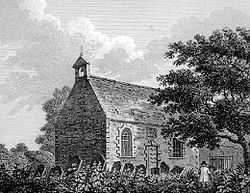Drumcondra Church
| Drumcondra Church | |
|---|---|
 A view of the church and churchyard, by Daniel Grose, c. 1790, from Antiquities of Ireland, Vol. II | |
| 53°22′7″N 6°15′20″W / 53.36861°N 6.25556°W | |
| Location | Drumcondra, Dublin |
| Country | Ireland |
| Denomination | Church of Ireland |
| History | |
| Founder(s) | Mary Coghill |
| Dedication | St. John the Baptist |
| Administration | |
| Diocese | Diocese of Dublin and Glendalough |
| Province | Province of Dublin |
Drumcondra Church is a Church of Ireland church located in Drumcondra, Dublin, previously in the Civil Parish of Clonturk. The church and its churchyard contain memorials to a number of notable historical figures.
History
In 1743 the dilapidated old church of the parish of Clonturk was rebuilt by a Miss Coghill as a memorial to her brother, Dr. Marmaduke Coghill, who died in 1738.[1] On the north-side of the church is the large tomb of Dr. Coghill, born in 1673 in Dublin, who was a judge of the Prerogative Court and Chancellor of the Exchequer, as well as being an MP in the Irish Parliament. On the tomb reclines his effigy in his official robes, with figures of Minerva and Religion below.[2][3]
By about 1721, Marmaduke Coghill was in control of the interments. In 1733 Henry Hamilton was succeeded as incumbent by Edward Hudson, followed by Robert Johnson in 1740, in 1748 James Edkins, 1781 Charles O'Neill, 1789 Jacob Cramer, 1816 William Barlow, and in 1826, James Duncan Long.[4]
Notable burials
Notable people buried in the churchyard include:
- James Gandon (1743–1823), architect, designer of the Custom House, Dublin.[5] Gandon was buried by his own request in the grave of his lifelong friend, Francis Grose.
- Francis Grose (1731–1791), antiquary, died in the home of Horace Hone and was buried 18 May 1791 on the south-side of the churchyard in the presence of his nephew Lieutenant Daniel Grose, Horace and Camillus Hone, James Gandon and Christopher Pack the painter. A view of the church and churchyard drawn by Daniel Grose bears the inscription: To James Gandon and Samuel Walker Esqrs., Mr. Horace Hone and Richd. Edwd. Mercier who attended the funeral of the late Francis Grose Esqr. to the Church of Drumcondra near Dublin, where his Remains were deposited 18th May, 1791. The figure of Captain Grose in the image is placed on his own grave.
- Thomas Furlong, poet, who translated Carolan's The Irish Minstrelsy, died in 1827 aged 33 years and was buried near the monument of Francis Grose.[6] His grave bore the memorial: To the Memory of Thomas FURLONG, Esq. In whom the purest principles of Patriotism and honour were combined with Superior Poetic Genius This Memorial of Friendship is erected by those who valued and admired his various talents, public integrity and private worth. He died 25th July, 1827 aged 33 years. May he rest in peace![7]
- Theophilus Moore, who was buried near Thomas Furlong, settled on the Palmerston estate in Old Rathmines and opened an academy where Thomas Moore the poet, a namesake and kinsman, attended. Shortly after coming to Dublin, Theophilus Moore first published Old Moore's Almanac in 1764.[8]
- George Grierson (c 1678–1753), printer and publisher. In 1720 he was one of the churchwardens. Grierson married three times. His first wife was buried on 19 May 1726.[9] He married secondly in 1726 the talented editor and poet Constantia Crawley, who was buried 4 December 1732[10] and other Griersons were buried 30 July 1731,[11] 20 March 1732,[12] and 11 March 1739.[13][14][15]
- Patrick Heeney (1881–1911), composer of the music of the Irish national anthem "Amhrán na bhFiann" ("The Soldier's Song").
- Two Commonwealth service war graves - a Drummer of the Royal Engineers of World War I and a Royal Naval Volunteer Reserve officer of World War II.[16]
The Birth, Marriage and Death records are held in the Representative Church Body Library in Churchtown, Dublin.
Refurbishment
A report of 1831 stated that the churchyard was in a deplorable condition - no sooner was a body buried but it was removed by body-snatchers. Over the following two years the church and churchyard were renovated and a cottage was provided for a watchman to watch over the graves at all times.[5]
References
- ↑ Dublin Historical Record
- ↑ Topographical Dictionary of Ireland
- ↑ Illustration of the Monument to Marmaduke Coghill, in Southern Fingal - being The Sixth Part of a History of County Dublin (1920) by Francis Elrington Ball, p. 172
- ↑ Ball, Francis Erlington (1902). A history of the County Dublin; the people, parishes and antiquities from the earliest times to the close of the eighteenth century - Volume 6. Alex Thom. p. 183.
- ↑ 5.0 5.1 Irish Times, 11 March 1940, p. 4
- ↑ D'Alton's County of Dublin, p.247
- ↑ Journal of the Association for the Preservation of the Memorials of the Dead in Ireland, Vol 6. FHL film # 0258795
- ↑ Dublin Historical Record, vol.3, no.1., Sep-Nov 1940, pp.31-32
- ↑ (RCB, P328/1/3, book 3, p.91)
- ↑ (book 3, p.97)
- ↑ (book 3, p.96)
- ↑ (book 3, p.98)
- ↑ (book 3 p.104)
- ↑ J.R.H. Greeves, King's Printers; notes on the family of Grierson; Irish Genealogists, Volume 2, (1955), pp. 303-307.
- ↑ Two Irish printing families, proceedings of the Belfast Natural History Society, SER. 2, 4 (1955), pp. 38-44.
- ↑ CWGC Cemetery Report. Details obtained from casualty record.
- Journal of the Irish Memorial Association; now incorporating the Dublin Parish Register Society, edited by Thomas Ulick Sadlier
- Parish Register Society vol. XI (1920-1925) no.3. Parish Registers. St. John's Dublin, Marriages 1700-1798.